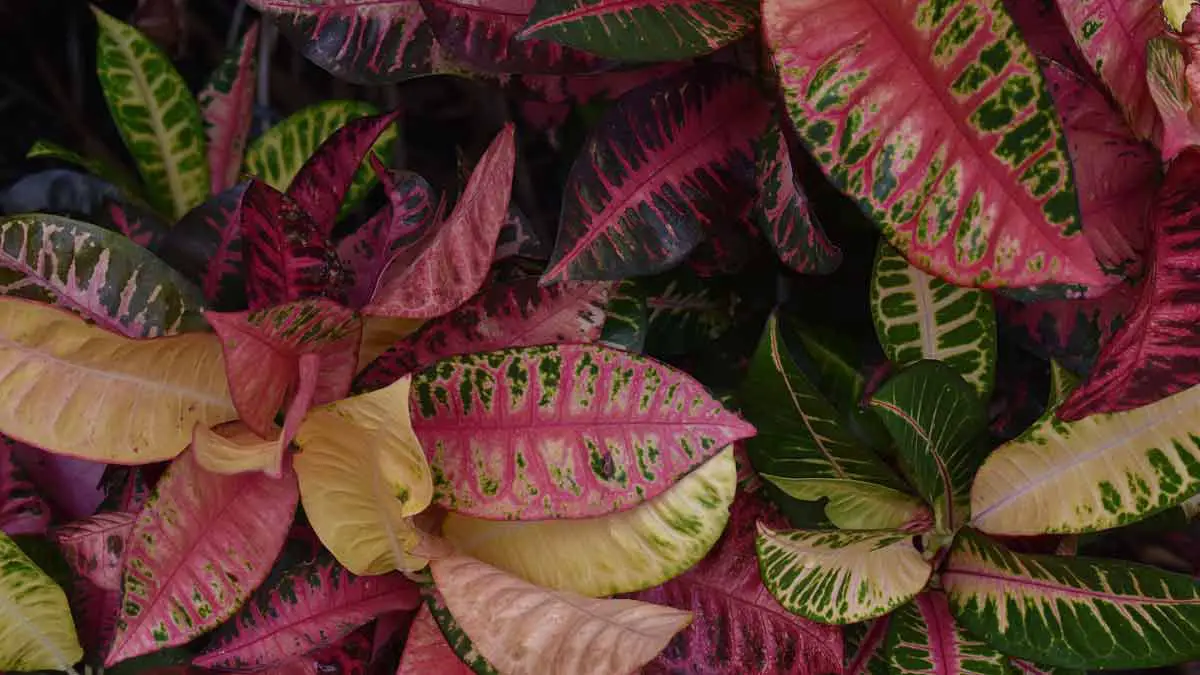Croton plants are known for their vibrant, multi-colored leaves.
If you notice your croton leaves drooping, it can cause concern.
While there are several possible explanations, there are also several solutions.
Drooping leaves can be caused by insufficient light, too much water, or too little water. It can also be a sign of pests, among other things.
This article will go over the most common causes of drooping leaves on croton plants and what you can do to fix the issue.
Why Are My Croton Leaves Drooping and How Can You Fix It?
Croton plants are beautiful, vibrant houseplants that add a touch of color to any room.
When healthy, these plants have glossy, bright leaves in various colors, including yellow, green, orange, and red.
Croton plants are known for being relatively easy to care for. However, they can be sensitive to changes in their environment.
One of the most common problems croton owners face is drooping leaves.
If you notice your croton’s leaves drooping, it’s essential to take action quickly to prevent further damage to your plant.
There are several possible reasons why your croton’s leaves might be drooping.
The most common include:
1. Insufficient Light
Croton plants need a lot of bright indirect sunlight to thrive.
If your plant is not getting enough light, its leaves will start to droop because it cannot produce enough food.
How To Tell If Your Croton Needs More Light
The easiest way to tell if your croton needs more light is by looking at the color of its leaves.
If the leaves are pale or yellow, this is a sign that your plant is not getting enough light.
Other signs that your croton needs more light include:
- Leaves that are small or stunted
- Leaves that are falling off
- Slow growth
How To Fix a Croton That Needs More Light
If you think your croton needs more light, the best solution is to move it to a brighter location.
A spot near a sunny window would be ideal. West- or south-facing windows are best since they get the most light.
If you cannot move your plant to a brighter location, you can also try using artificial lighting such as grow lights.
2. Too Little Water
Croton plants need to be watered regularly to stay healthy.
However, too much or too little water can both cause problems.
If you do not water your croton often enough, the leaves will start to droop as the plant dries out.
How To Tell If Your Croton Is Getting Too Little Water
The easiest way to tell if your croton needs more water is to check the potting soil.
If the top inch or two of soil is dry, it’s time to water your plant.
Other signs that your croton needs more water include:
- Leaves that are wilting or limp
- Yellow or brown leaves
- Soil that is dry and crumbly
- Leaf drop
- Slow growth
How To Fix a Croton That Is Getting Too Little Water
If you think your croton needs more water, it is best to water it thoroughly.
Allow the water to soak into the soil until it is moist but not soggy.
Croton plants need to be watered about once a week, although this may vary depending on the type of soil and the size of the pot.
The best way to tell if your croton needs water is to check the soil before watering.
If the soil is dry, water your plant.
If the soil is still moist, wait a few days before watering again.
3. Too Much Water
While crotons must be watered regularly, too much water can also be a problem.
If you water your croton too often, the roots will start to rot, and the leaves will droop.
The plant cannot get the oxygen it needs from the waterlogged soil.
How To Tell If Your Croton Is Getting Too Much Water
The easiest way to tell if your croton is getting too much water is to check the soil.
If the soil is soggy or waterlogged, this is a sign that your plant is getting too much water.
Other signs that your croton is getting too much water include:
- Leaves that are wilting or limp
- Yellow or brown leaves
- Soil that is soggy or muddy
- Black spots on the leaves
- Root rot
How To Fix a Croton That Is Getting Too Much Water
If you think your croton is getting too much water, the best solution is to stop watering it until the soil has a chance to dry out.
Once the soil is dry, water your plant only as often as needed to keep the soil moist but not soggy.
If your plant roots are already mushy or rotting, you will need to repot the plant in fresh, dry soil.
4. Low Humidity
Croton plants are native to tropical environments and prefer high humidity.
If the air around your plant is too dry, the leaves will start to droop.
This is because the plant cannot get the moisture it needs from the air.
How To Tell If Your Croton Needs More Humidity
The easiest way to tell if your croton needs more humidity is to check the leaves.
If the leaves are dry or crispy, this is a sign that the air around your plant is too dry.
Other signs that your croton needs more humidity include:
- Leaves that are wilting or limp
- Brown tips on the leaves
- Slow growth
How To Fix a Croton That Needs More Humidity
There are several ways to increase the humidity around your croton plant.
One way is to mist the leaves with water every day.
Another way is to place the pot on a tray of pebbles and water. The water will evaporate and increase the humidity around the plant.
You can also use a humidifier to add moisture to the air.
5. Heat Stress
Croton plants prefer warm, humid environments.
If the temperature around your plant gets too hot, the leaves will start to droop.
This is because the plant cannot cool down and maintain its moisture levels.
How To Tell If Your Croton Is Stressed By Heat
Checking the leaves is the easiest way to tell if your croton is stressed by heat.
If the leaves are wilting or drooping, this is a sign that the plant is not able to cool itself down.
Other signs that your croton is stressed by heat include:
- Yellow or brown leaves
- Leaves that are wilting or limp
- Slow growth
- Brown tips on the leaves
How To Fix a Croton That Is Stressed By Heat
If you think your croton is stressed by heat, moving it to a cooler location is best.
Croton plants prefer temperatures between 60 and 80 degrees Fahrenheit.
If the temperature around your plant is higher, move it to a cooler area or provide some shade.
You can also mist the leaves with water to help cool the plant down.
Avoid placing the plant in direct sunlight, as this will further stress the plant.
6. Pest Infestation
Pests can also cause croton droopy leaves.
If your plant is infested with pests, the Croton leaves will start to turn yellow or brown and may eventually fall off.
Common pests that attack croton plants include aphids, mealybugs, and scale insects.
Aphids are small, green insects that suck the sap out of plants.
Mealybugs are white, fuzzy insects that feed on plant juices.
Scale insects are small, brown insects that attach themselves to plants and suck their sap out.
How To Tell If Your Croton Is Infested With Pests
The easiest way to tell if your croton is infested with pests is to check the leaves.
If you see any insects on the leaves, this is a sign that your plant has a pest problem.
Other signs that your croton is infested with pests include:
- Yellow or brown leaves
- Leaves that are wilting or limp
- Black spots on the leaves
- Holes in the leaves
How To Fix a Croton That Is Infested With Pests
If you think your croton is infested with pests, the best solution is to treat it with a natural pesticide.
Neem oil is a natural pesticide that is effective against various pests.
Mix 1 teaspoon of neem oil with 1 cup of water and spray it on the plant.
You can also use insecticidal soap to kill the pests.
To make insecticidal soap, mix 1 tablespoon of dish soap with 1 cup of water and spray it on the plant.
You can also remove pests by hand using a cotton swab dipped in rubbing alcohol.
7. Transplant Shock
Transplant shock is another common reason why croton leaves droop.
When you transplant a croton plant, the roots are disturbed, and the plant goes into shock.
This can cause the leaves to droop and turn yellow or brown.
How To Tell If Your Croton Is In Transplant Shock
The easiest way to tell if your croton is in shock is to check the leaves.
If you just have transplanted the plant, and the leaves are wilting or drooping, this is a sign that the plant is in shock.
Other signs that your croton is in shock include:
- Yellow or brown leaves
- Leaves that are wilting or limp
- Slow growth
- Brown tips on the leaves
How To Fix a Croton That Is In Transplant Shock
If you think your croton is in shock, the best solution is to give it time to adjust.
Transplant shock can last several weeks, but the plant will eventually recover.
In the meantime, make sure to water the plant regularly and keep it in a warm, sunny location.
Do not fertilize the plant until it has recovered from the shock.
How To Prevent Croton Leaves From Drooping
Croton leaves may droop for various reasons, including insufficient light, overwatering, or pests.
However, you can do a few things to prevent croton leaves from drooping.
- Make sure your croton is getting enough light. Crotons need bright indirect light to thrive. If your croton is not getting enough light, its leaves will droop.
- Water your croton when the top inch of soil is dry. Overwatering can cause croton leaves to droop.
- Inspect your croton for pests. If you see any pests on your crotons, such as aphids or mealybugs, treat them with an appropriate insecticide.
- Fertilize your croton every two weeks during the growing season. Use a balanced fertilizer that contains nitrogen, phosphorus, and potassium.
- Prune your croton as needed to remove any dead or dying leaves.
- Avoid placing your croton in a drafty location. Crotons are tropical plants and prefer warm, humid conditions.
- Place your croton in a well-ventilated room. Crotons are susceptible to fungal diseases if not in a well-ventilated room.
- Check the leaves of your croton for signs of stress. If you see any yellowing or browning leaves, try to address the cause of the stress.
- Provide your croton with additional humidity if needed. Crotons prefer high humidity and will benefit from being placed in a room with a humidifier.
- Keep an eye on your croton and make sure it is not under or overwatered, stressed, or infested with pests. By taking these precautionary measures, you can help prevent your croton leaves from drooping.
Final Thoughts
Croton leaves may droop for various reasons, including insufficient light, overwatering, or pests.
If your croton leaves are drooping, the best solution is to identify the cause and take appropriate action.
In most cases, the problem can be easily fixed, and your croton will recover.
Croton plant care is not complex, but it is essential to keep an eye on your indoor plant and take action if you notice any problems.
By taking these precautions, you can help prevent your croton leaves from drooping.







